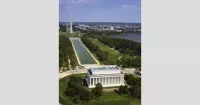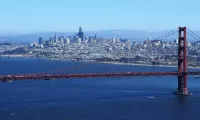Congestion pricing is a surcharge system applied to public goods experiencing high demand, such as roads, public transport, electricity, and communication networks. By increasing prices during peak hours, it aims to reduce congestion and manage demand without necessarily expanding the existing infrastructure. Examples include higher fees for bus services during rush hour, peak electricity rates, and road pricing to alleviate traffic. This strategy is also used for airlines and shipping companies, with higher fees for airport slots and canal usage during busy periods.
1952: Vickrey proposes time-based fare for NYC Subway
In 1952, Nobel laureate William Vickrey proposed adding a distance- or time-based fare system for the New York City Subway.
1964: Smeed Report recommendations rejected
In 1964, the Smeed Report, published by the British Ministry of Transport, considered congestion pricing but its recommendations were rejected by successive British governments.
1968: First Congestion Pricing Scheme Started at New York City Airports
In 1968, the first congestion pricing scheme was started with higher landing fees for peak-hour use by aircraft with 25 seats or fewer at Newark, Kennedy, and LaGuardia airports in New York City.
1972: BAA Implemented First Peak Pricing Policy
In 1972, the British Airports Authority (BAA) implemented the first peak pricing policy, with surcharges varying depending on the season and time of the day.
1975: Singapore introduces congestion pricing
In 1975, Singapore became the first country to introduce congestion pricing on its urban roads.
1975: Singapore Area Licensing Scheme implemented
In 1975, the first implementation of a congestion pricing scheme was the Singapore Area Licensing Scheme, along with other measures and improvements in mass transit.
1976: BAA Raised Peak Charges
By 1976, the British Airports Authority (BAA) raised these peak charges.
1983: Hong Kong pilot test on electronic congestion pricing system
Between 1983 and 1985, Hong Kong conducted a pilot test on an electronic congestion pricing system with positive results.
1984: London-Heathrow Had Seven Pricing Structures
London-Heathrow had seven pricing structures between 1976 and 1984.
1985: Hong Kong pilot test on electronic congestion pricing system
Between 1983 and 1985, Hong Kong conducted a pilot test on an electronic congestion pricing system with positive results.
1986: Bergen introduces tolled entrances
In 1986, Bergen became the first city in Norway to introduce tolled entrances to the more central urban areas.
1986: Bergen Pioneered Electronic Urban Tolling
In 1986, Bergen pioneered the implementation of electronic urban tolling in the main corridors.
1988: Higher Landing Fee for Smaller Aircraft at Boston's Logan Airport
In 1988 a higher landing fee for smaller aircraft at Boston's Logan Airport was adopted; with this measure much of the general aviation abandoned Logan for secondary airports.
1988: US Carriers Won International Arbitration Case
In 1988, the US carriers won their case in international arbitration against the British Airports Authority (BAA).
1990: Oslo Implemented Electronic Urban Tolling
In 1990, Oslo implemented electronic urban tolling in the main corridors.
1991: Trondheim Implemented Electronic Urban Tolling
In 1991, Trondheim implemented electronic urban tolling in the main corridors.
1991: Athens Airport Charged Higher Landing Fee
In 1991, the Athens Airport charged a 25% higher landing fee for those aircraft arriving between 11:00 and 17:00 during the high tourism season during summer.
1992: Autoroute A1 Implemented Congestion Pricing
Since 1992 congestion prices have been applied on Autoroute A1 in Northern France during weekends.
1995: California's 91 Express Lanes Implemented
In 1995, California's private toll 91 Express Lanes, in Orange County was the first practical implementation of high-occupancy toll lanes (HOT).
1995: 11 Bills Presented in the City Council to Introduce Congestion Pricing since 1995
Since 1995, 11 bills have been presented in the city council to introduce congestion pricing
1996: Interstate 15 in San Diego Implemented
In 1996, Interstate 15 in San Diego was implemented.
1996: Road Space Rationing in Force Since 1996
Since 1996, road space rationing by the last digit of the license plate has been in force in Sao Paulo
1998: Refinement of Singapore's congestion pricing
Singapore refined its initial congestion pricing system in 1998.
2000: Reduction of vehicle kilometres in London between 2000 and 2012
TfL reported an overall reduction of 11% in vehicle kilometres in London between 2000 and 2012 as a result of the charging scheme
March 2001: PANYNJ Implemented Discount for E-ZPass Users
In March 2001, the Port Authority of New York and New Jersey (PANYNJ) implemented a discount on regular toll fees during off-peak hours for vehicles paying electronically with an E-ZPass issued in New York State.
2001: Norwegian Parliament Approved Legislation to Implement Congestion Charges
In 2001, Norwegian Parliament approved legislation to implement congestion charges in cities
2001: Rome implements congestion pricing
In 2001, Rome implemented a congestion pricing scheme.
October 2002: Durham introduces charges
In October 2002, Durham introduced congestion charges, reducing vehicle traffic significantly.
2002: Edinburgh initiates implementation process
In 2002 Edinburgh, United Kingdom, initiated an implementation process for congestion pricing.
2003: Study on London congestion pricing effects
A 2020 study of London found that congestion pricing (introduced in 2003) led to reductions in pollution and reductions in driving, but it increased pollution from diesel vehicles (which were exempt from the congestion pricing).
2003: London implements congestion pricing
In 2003, London implemented a congestion pricing scheme.
2003: Testimony to United States Congress Joint Economic Committee
In 2003, testimony to the United States Congress Joint Economic Committee summarized the transport economics rationale for implementing congestion pricing on roads.
2004: Santiago de Chile Implemented Urban Toll for a Freeway passing through a downtown area
Between 2004 and 2005, Santiago de Chile implemented the first 100% non-stop urban toll for a freeway passing through a downtown area, charging by the distance traveled.
2005: Santiago de Chile Implemented Urban Toll for a Freeway passing through a downtown area
Between 2004 and 2005, Santiago de Chile implemented the first 100% non-stop urban toll for a freeway passing through a downtown area, charging by the distance traveled.
2005: Edinburgh rejects congestion pricing proposal
In 2005, a referendum in Edinburgh rejected the congestion pricing proposal.
August 2006: Highest Toll Paid for Panama Canal Transit Slot Auction
In August 2006, the highest toll for high priority passage paid through the Transit Slot Auction was US$220,300 charged on a tanker, bypassing a 90-ship queue awaiting the end of maintenance works on the Gatun locks, thus avoiding a seven-day delay.
December 2006: Singapore pilots traffic estimation and prediction tool with IBM
From December 2006 to April 2007, Singapore's LTA, along with IBM, ran a pilot with a traffic estimation and prediction tool (TrEPS).
2006: Study on Stockholm congestion pricing effects
A 2019 study of congestion pricing in Stockholm between 2006 and 2010 found that, in the absence of congestion pricing, Stockholm's air would have been 5 to 15 percent more polluted between 2006 and 2010, and that young children would have suffered substantially more asthma attacks.
2006: San Francisco starts feasibility study
In 2006, San Francisco transport authorities began a feasibility study to evaluate the introduction of congestion pricing.
2006: Stockholm implements congestion pricing trial
In 2006, Stockholm implemented a seven-month congestion pricing trial.
2006: TfL observed that traffic flows were lower than in any recent year
In 2006, the last year before the zone was expanded, TfL observed that traffic flows were lower than in any recent year, while network traffic speeds were also lower than in any recent year.
2006: ACP Introduced 25th Transit Slot
Since 2006, ACP has available a 25th slot, sold through the Transit Slot Auction to the highest bidder.
2006: Increase in road works since 2006
since 2006 there has been an increase in road works by utilities and general development activity
April 2007: Singapore pilots traffic estimation and prediction tool with IBM
From December 2006 to April 2007, Singapore's LTA, along with IBM, ran a pilot with a traffic estimation and prediction tool (TrEPS).
August 2007: US DOT selects metropolitan areas for congestion pricing projects
In August 2007, the United States Department of Transportation selected five metropolitan areas to initiate congestion pricing demonstration projects under the Urban Partnerships Congestion Initiative.
2007: Congestion tax introduced permanently
Congestion tax was introduced permanently in 2007.
2007: Reported business impact from London congestion charge extension
Following the 2007 extension of London's congestion charge, reports varied with some indicating that business activity within the charge zone had been higher in both productivity and profitability and that the charge had a "broadly neutral impact" on the London wide economy, while others claiming an average drop in business of 25%.
2007: London congestion pricing extended
In 2007, London's congestion pricing zone was extended.
2007: New York City shelves pilot program proposal
In 2007, New York City shelved a proposal for a three-year pilot program for implementation in Manhattan.
2007: Western Extension established
In 2007, the Western Extension was established for the congestion charging zone.
2007: Work started on expansion of the Panama Canal
In 2007, work started on the expansion of the Panama Canal through a new third set of locks.
2007: Congestion Pricing Used during Rush Hours in Santiago de Chile
Since 2007, congestion pricing has been used during rush hours in Santiago de Chile to maintain reasonable speeds within the city core.
January 2008: Milan begins Ecopass trial
In January 2008, Milan began a one-year trial program called Ecopass, charging low emission vehicles and exempting cleaner ones.
March 2008: PANYNJ Introduced Green Pass Discount for Low-Emission Vehicles
Since March 2008, qualified low-emission automobiles with a fuel economy of at least 45 miles per gallon are eligible to receive a Port Authority Green Pass, which allows for a 50% discount during off-peak hours.
July 2008: London drops new CO2 charging structure
In July 2008, London's Mayor Boris Johnson announced that the new CO2 charging structure would no longer be implemented.
October 2008: London drops new CO2 charging structure
In October 2008, London's Mayor Boris Johnson announced that the new CO2 charging structure would no longer be implemented.
December 2008: Initial pricing scenarios presented
In December 2008, initial congestion pricing scenarios were presented in public meetings in San Francisco.
December 2008: Greater Manchester congestion scheme rejected
On 12 December 2008, the Greater Manchester congestion scheme was overwhelmingly rejected by a public referendum.
2008: NYC replaced in Urban Partnerships Congestion Initiative
In 2008, New York City left the Urban Partnerships Congestion Initiative and was replaced by Metro ExpressLanes in Los Angeles County.
2008: New York City proposition denied
In 2008, a new congestion pricing proposition in New York City was denied, and potential federal grants were reallocated.
2008: West Midlands councils reject congestion pricing
In 2008, councils from across the West Midlands in the United Kingdom rejected congestion pricing schemes.
January 2009: Variable Tolls Implemented at Sydney Harbour Bridge
In January 2009, variable tolls were implemented at Sydney Harbour Bridge, two weeks after upgrading to 100% free-flow electronic toll collection, making it Australia's first road congestion pricing scheme.
2009: Commute Delays Decreased at San Francisco–Oakland Bay Bridge
According to the Bay Area Toll Authority, commute delays in the first six months of 2010 have dropped by an average of 15 percent compared with 2009 after the congestion tolls implementation
2009: Panama Canal Projected to Reach Maximum Sustainable Capacity
The Panama Canal Authority (ACP) estimated that the canal would reach its maximum sustainable capacity between 2009 and 2012.
July 2010: Congestion Tolls Implemented at San Francisco–Oakland Bay Bridge
In July 2010, congestion tolls were implemented at the San Francisco–Oakland Bay Bridge, charging US$6 during peak hours and US$5 on weekends.
November 2010: Final study results announced
In November 2010, the final results of San Francisco's congestion pricing study were announced, proposing modified alternatives.
2010: Study on Stockholm congestion pricing effects
A 2019 study of congestion pricing in Stockholm between 2006 and 2010 found that, in the absence of congestion pricing, Stockholm's air would have been 5 to 15 percent more polluted between 2006 and 2010, and that young children would have suffered substantially more asthma attacks.
2010: Congestion Pricing Proposed in Beijing and Guangzhou
In 2010, congestion pricing was initially proposed in Beijing and recommended by the World Bank. A similar scheme was proposed for Guangzhou, with a public discussion revealing strong opposition to the charges.
2010: Time differing fees introduced in Trondheim
Starting with Trondheim in 2010, later in Kristiansand, Bergen and Oslo, time differing fees were introduced.
January 4, 2011: London removes Western Extension from congestion charging zone
On January 4, 2011, London removed the 2007 Western Extension from the congestion charging zone, increased the basic charge to £10, and introduced an automated payment system.
September 2011: Beijing Announces Congestion Pricing Plans
In September 2011, local officials in Beijing announced plans to introduce congestion pricing. No details were provided regarding the magnitude of the charges or the charge zone.
October 2011: Norway Announces Rules Allowing Congestion Charging in Cities
In October 2011, the Norwegian government announced the introduction of rules allowing congestion charging in cities to cut emissions and relieve traffic.
2011: Vehicle Quota System Introduced in 2011
In 2011, a vehicle quota system was introduced in Beijing, awarding new car licenses through a lottery.
December 31, 2011: Ecopass program ends
On December 31, 2011, the Ecopass program in Milan ended.
January 2012: Brazil Enacts Urban Mobility Law
In January 2012, Brazil's federal government enacted the Urban Mobility Law, authorizing municipalities to implement congestion pricing to reduce traffic flows and encourage public transportation.
January 16, 2012: Milan replaces Ecopass with Area C
On January 16, 2012, Milan replaced the Ecopass program with Area C, converting the scheme from a pollution charge to a congestion charge.
April 2012: São Paulo Committee Approves Congestion Pricing Bill
In April 2012, a São Paulo city council committee approved a bill to introduce congestion pricing within the existing road space rationing area.
November 2012: São Paulo's Strategic Urban Development Plan Proposes Congestion Pricing by 2025
In November 2012, São Paulo's strategic urban development plan "SP 2040" proposed the implementation of congestion pricing by 2025, contingent on metro and bus corridor density.
November 2012: Transport for London proposes to abolish the Greener Vehicle Discount
In November 2012, Transport for London (TfL) presented a proposal to abolish the Greener Vehicle Discount.
2012: HOT Lanes in the United States by 2012
According to the Texas A&M Transportation Institute, by 2012 there were in the United States 722 corridor-miles of HOV lanes, 294 corridor-miles of HOT/Express lanes and 163 corridor-miles of HOT/Express lanes under construction.
2012: Reduction of vehicle kilometres in London between 2000 and 2012
TfL reported an overall reduction of 11% in vehicle kilometres in London between 2000 and 2012 as a result of the charging scheme
2012: Panama Canal Projected to Reach Maximum Sustainable Capacity
The Panama Canal Authority (ACP) estimated that the canal would reach its maximum sustainable capacity between 2009 and 2012.
January 1, 2013: Hybrid vehicle exemption deadline
On January 1, 2013, the exemption for hybrid electric and bi-fuel natural gas vehicles (CNG and LPG) was originally set to expire.
January 2013: Gothenburg congestion tax implemented
In January 2013, the Gothenburg congestion tax was implemented, modeled after the Stockholm scheme.
March 2013: Area C made permanent
In March 2013, the Area C scheme in Milan was made permanent, with net earnings invested in sustainable mobility.
April 2013: Brazil's Urban Mobility Law Goes Into Effect
In April 2013, the Urban Mobility Law enacted by Brazil went into effect, authorizing congestion pricing and promoting public transportation.
July 2013: Ultra Low Emission Discount (ULED) goes into effect
On July 1, 2013, the Ultra Low Emission Discount (ULED) went into effect, limiting free access to the congestion charge zone to selected vehicles.
2013: Seattle congestion pricing study
A 2013 study found that after congestion pricing was implemented in Seattle, drivers reported greater satisfaction with the routes covered by congestion pricing and reported lower stress.
2013: Beijing's Motor Vehicle Emission Control Plan 2013-2017
According to city's motor vehicle emission control plan 2013, the congestion charge will be a real-time variable pricing scheme based on actual traffic flows and emissions data, and allow the fee to be charged for different vehicles and varying by time of the day and for different districts.
2013: TfL Reports on Congestion Charging Scheme
In 2013, ten years since its implementation, TfL reported that the congestion charging scheme resulted in a 10% reduction in traffic volumes from baseline conditions.
November 2015: Norway Implements Urban Charging Schemes in Additional Cities
As of November 2015, Norwegian authorities have implemented urban charging schemes in five additional cities or municipalities: Haugesund, Kristiansand, Namsos, Stavanger, and Tønsberg.
December 2015: Beijing Announces Congestion Charge Plans for 2016
In December 2015, the Beijing Municipal Commission of Transport announced plans to introduce congestion charges in 2016. The charge will be a real-time variable pricing scheme based on traffic flows and emissions data.
2015: Trial implementation in San Francisco
An updated proposal calls for implementing a six-month to one-year congestion pricing trial in San Francisco in 2015.
January 2016: Congestion taxes increased in Stockholm
On 1 January 2016, congestion taxes were increased in the inner-city parts of Stockholm, and also the congestion tax was introduced on Essingeleden motorway.
May 2016: Beijing Considers Traffic Congestion Charges by 2020
In May 2016, the Beijing city legislature announced it will consider starting to levy traffic congestion charges by 2020 as part of a package of measures to reform the vehicle quota system.
June 2016: Expanded Panama Canal Entered Commercial Operation
In June 2016, the expanded Panama Canal entered commercial operation, featuring new locks to allow transit of larger, Post-Panamax ships.
June 2016: Beijing Departments Working on Congestion Pricing Proposal
As of June 2016, Beijing's environmental and transport departments are collaborating on a congestion pricing proposal.
2016: Studies on Singapore congestion pricing
In 2016, a study found that more people used public transportation due to increases in congestion pricing in Singapore, and another study found that real estate prices dropped by 19% within the cordoned-off areas of Singapore where congestion pricing was in place relative to the areas outside of the area.
December 31, 2016: Exemption postponed
On December 31, 2016, Exemption has been postponed.
October 2017: T-charge introduced in London
In October 2017, London introduced a new toxicity charge, known as T-charge, for older and more polluting vehicles.
2017: Cuomo reintroduces congestion pricing proposal
In 2017, Governor Andrew Cuomo reintroduced a congestion pricing proposal for New York City.
2017: Vehicle Quota System Ceiling Set by 2017
In 2017, the vehicle quota system was introduced in 2011, awarding new car licenses through a lottery, with a ceiling of 6 million units set by the city authority.
March 2019: Cuomo's plan approved
In March 2019, Cuomo's congestion pricing plan for New York City was approved.
April 2019: T-charge expanded into Ultra Low Emission Zone (ULEZ)
On April 8, 2019, the T-charge in London was expanded into the Ultra Low Emission Zone (ULEZ).
2019: Study on Stockholm congestion pricing effects
A 2019 study of congestion pricing in Stockholm between 2006 and 2010 found that, in the absence of congestion pricing, Stockholm's air would have been 5 to 15 percent more polluted between 2006 and 2010, and that young children would have suffered substantially more asthma attacks.
2019: Interstate 66 average round trip prices are much lower
Interstate 66 in the Washington, D.C., metro area, average, round trip prices are $11.88 in 2019
2020: Study on driving restrictions in Beijing
A 2020 study that analyzed driving restrictions in Beijing estimated that the implementation of congestion pricing would reduce total traffic, increase traffic speed, reduce pollution, reduce greenhouse gas emissions, reduce traffic accidents, and increase tax revenues.
2020: Price per passage in Oslo
In 2020, the price is typically NOK 28 (€2.37) per passage, but to enter Oslo to the inner city and leave means passing five stations which costs NOK 126 (€10,66).
2020: Beijing Considers Traffic Congestion Charges by 2020
In May 2016, the Beijing city legislature announced it will consider starting to levy traffic congestion charges by 2020 as part of a package of measures to reform the vehicle quota system.
2020: Interstate 66 average round trip prices are much lower
Interstate 66 in the Washington, D.C., metro area, average, round trip prices are $5.04 in 2020
2021: Study on CO2 emissions and congestion pricing
A 2021 study found that congestion pricing reduced CO2 emissions through downsizing commuting distances and housing sizes.
2021: Interstate 66 average round trip prices are much lower
Interstate 66 in the Washington, D.C., metro area, average, round trip prices are $4.75 in 2021
2022: earliest go-live date
congestion pricing in New York City would not go into effect until 2022 at the earliest
May 2023: MTA Finalized and Published Environmental Assessment
In May 2023, the Metropolitan Transportation Authority (MTA) finalized and published the Environmental Assessment (EA) of the congestion program, initiating a 30-day public comment period.
June 12, 2023: End of Public Comment Period for Environmental Assessment
On June 12, 2023, the 30-day public comment period for the Metropolitan Transportation Authority's (MTA) Environmental Assessment (EA) of the congestion program concluded.
June 22, 2023: FHWA Published Finding of No Significant Impact
On June 22, 2023, the Federal Highway Administration (FHWA) published its Finding of No Significant Impact (FONSI) decision for the congestion pricing project, determining that the Environmental Assessment (EA) adequately addressed public input, considered the impacts, and mitigated adverse effects.
June 26, 2023: Federal Highway Administration gives final approval
On June 26, 2023, the Federal Highway Administration gave its final approval, allowing the MTA to begin setting toll rates for the proposed congestion zone.
June 2024: Plan indefinitely postponed
On June 5, 2024, Governor Kathy Hochul announced the congestion pricing plan was indefinitely postponed.
October 2024: Thailand Plans Congestion Charge for Inner Bangkok
In October 2024, Thailand's Ministry of Transport announced plans for a 40-50 Baht congestion charge for motorists entering inner Bangkok, with funds subsidizing railway fares.
November 2024: Hochul announces an intent for the toll
In November 2024, Hochul announced an intent for the toll to go forward with a planned implementation on 5 January 2025, at a reduced rate.
January 2025: New Implementation Date
Hochul announced an intent for the toll to go forward with a planned implementation on 5 January 2025, at a reduced rate.
2025: Congestion pricing implemented in New York City
Congestion pricing in New York City was implemented in 2025, charging most vehicles entering Manhattan south of 60th Street.
2025: São Paulo's Strategic Urban Development Plan Proposes Congestion Pricing by 2025
In November 2012, São Paulo's strategic urban development plan "SP 2040" proposed the implementation of congestion pricing by 2025, contingent on metro and bus corridor density.
2040: São Paulo's Strategic Urban Development Plan Proposes Congestion Pricing by 2025
In November 2012, São Paulo's strategic urban development plan "SP 2040" proposed the implementation of congestion pricing by 2025, contingent on metro and bus corridor density.
2045: Projected Reduction in Crossings from Brooklyn to Congestion Zone
The Environmental Assessment (EA) data for a 2045 projection projected a 10.4% reduction in crossings from Brooklyn to the congestion zone which includes the BQE (Brooklyn-Queens Expressway) and other connected entryways such as the Manhattan and Brooklyn Bridge.
Mentioned in this timeline
California is a U S state on the Pacific Coast...

Boris Johnson a British politician and writer served as Prime...

Washington D C is the capital city and federal district...
Hong Kong is a Special Administrative Region of the People's...

San Francisco is a major commercial financial and cultural hub...

Los Angeles is the most populous city in California and...
Trending
1 month ago Christian Gonzalez shines for Patriots, recovers from concussion, ready for Week 10.

Kyle Van Noy is an American football linebacker currently playing for the Baltimore Ravens He played college football at BYU...
TreVeyon Henderson is an American professional football running back for the New England Patriots of the NFL He played college...

3 months ago Mike Vrabel on Patriots' Defense and Primetime Matchup Against Bills

3 months ago Cardi B and Nicki Minaj Feud Reignites With Scathing Messages and Online Sparring.
Marlon Humphrey is a professional football cornerback for the Baltimore Ravens in the NFL He played high school football at...
Popular

Candace Owens is an American conservative political commentator and author...

Tucker Carlson is an American conservative political commentator known for...

XXXTentacion born Jahseh Dwayne Ricardo Onfroy was a controversial yet...

Ben Shapiro is a prominent American conservative political commentator media...

William Franklin Graham III commonly known as Franklin Graham is...

Bill Gates an American businessman and philanthropist revolutionized personal computing...
